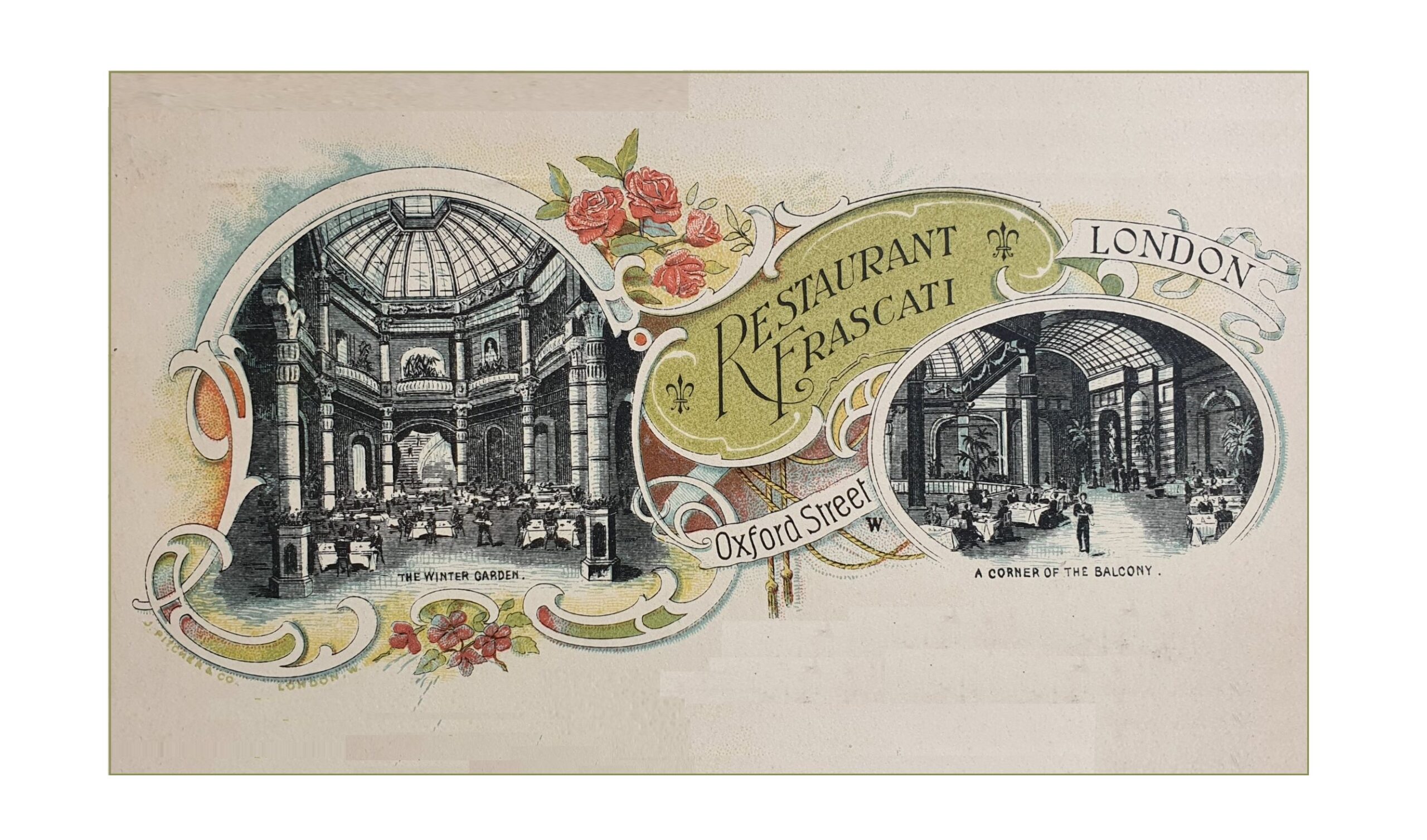
Prepare to salivate liberally at les cartes, yearn wistfully for decent service à table, and cast aside forcefully that MacDonald’s Big Mac as I dip a toast soldier into the golden yolk of exclusive restaurants and grand cafés of belle époque London. Digest descriptions of the places to see and be seen eating, and ruminate on some 2020 dining suggestions du jour that might capture a little of that bygone era – if you’re prepared to take out a second mortgage.
On today’s menu:
Frascati’s (1892 – 1954)
Frascati’s had a difficult birth. It was built on Oxford Street with a huge ‘winter garden’ – including overlooking balconies and a glass dome – as its centrepiece. When an alcohol license was denied, Dutch businessman A. W. Krasnapolsky bought the unopened building. He spent a fortune redecorating it in an over-the-top Renaissance style, gave it his own name and went bust within 6 months. Enter the owners of the Holborn Restaurant (see below), who renamed it ‘Frascati’ after no one in particular.
It then became one of the most celebrated and respectable places to dine in London, its French cuisine a favourite with businessmen and aristocracy alike. For a period, the Gastronomic Society held their monthly dinner there, which speaks volumes. Lieutenant-Colonel Newnham-Davis, an author and food critic, thought it suitable as a venue for dinner with an elderly cricket-playing clergyman in 1899. As well as the winter garden, Frascati’s had a grill room and numerous private dining areas, and it was renowned for its floral decorations and orchestra. This formula kept it going through both the roaring twenties and the turbulent thirties.
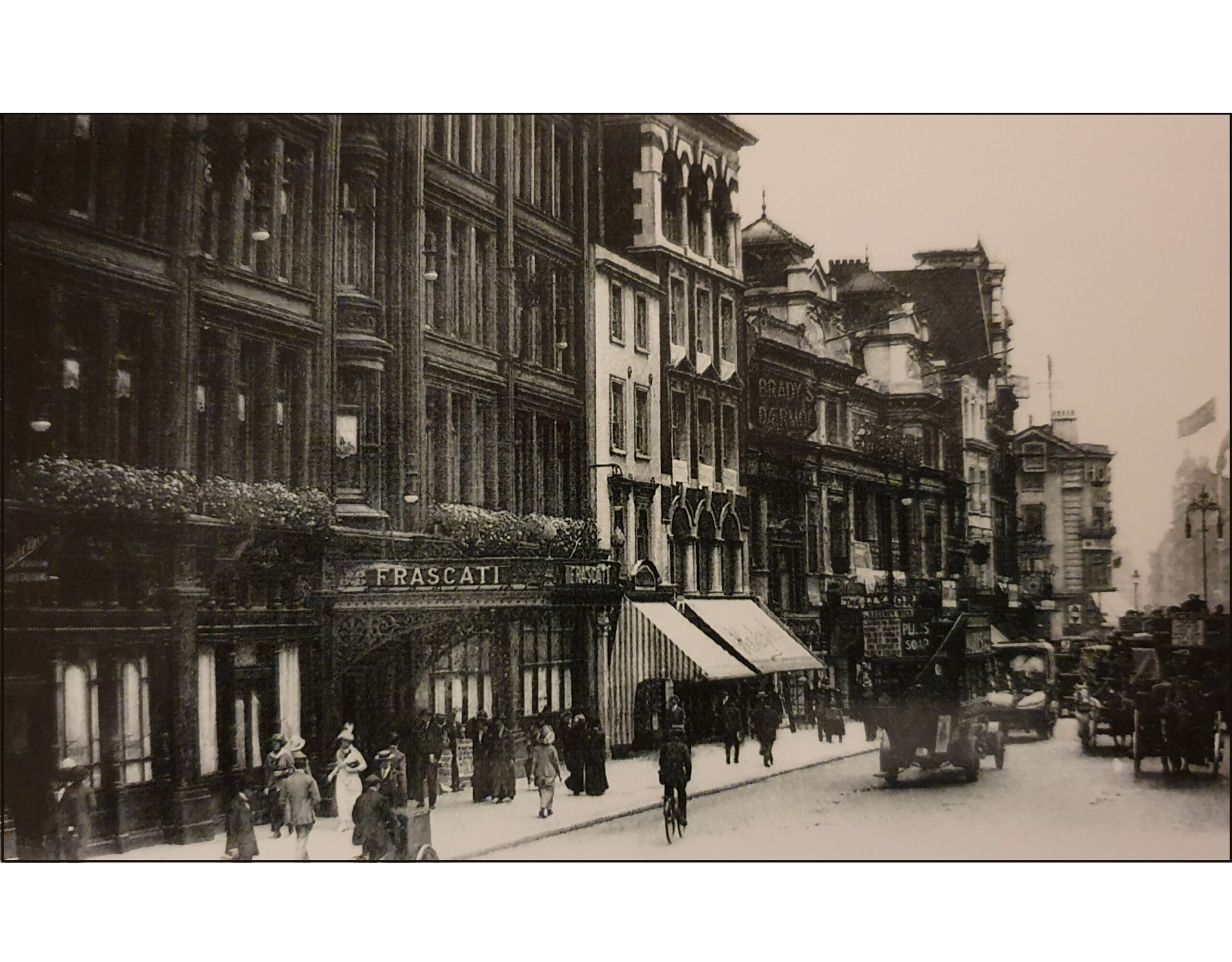
← A photograph from the Edwardian era, showing Frascati’s. Visible next to the restaurant are two shops and then the Oxford Music Hall. The Oxford was later rebuilt as a Lyons Corner House.
Primark now covers the entire site, although the frontage of Lyons survives.
However, having survived both wars relatively unscathed it faced a very different world: One where orchestras and floral displays and menus in French no longer brought in the punters; elderly cricket-playing clergymen were an endangered species, and retail space on Oxford Street was at a premium. It closed permanently to the public in March 1954. The building’s refurbishment in 1957 destroyed almost all reminders of its past, presenting a sleek new frontage with shops on the ground floor, a banking hall and offices above. Remarkably, the glass dome survived – boarded up and forgotten – until the building was finally demolished in 2013.
Notre suggestion du jour: Try the self-proclaimed grand café, the Wolesley, on Piccadilly. Further afield, Krasnapolsky’s 1883 Winter Garden in Amsterdam still exists in the Grand Hotel Krasnapolsky. However, if all you need is a glass dome to sip a morning coffee beneath, then the pretty – if petite – former banking hall that is now the foyer of the 5-star Threadneedles Hotel EC2 is considerably closer to home and spectacularly better value.
Dieudonné’s Hotel (c.1866 – 1914)
On Ryder Street, in the heart of the clubland of St. James’s, this establishment became fashionable when C. P. Guffanti bought it in 1895. It features in the short story ‘the Phantom Luncheon’ by Saki: Lady Drakmanton fears having to pay for lunch there with the boring Smithly-Dubbs sisters; in the event she cleverly and enjoyably gets the Smithly-Dubbs to pay for her lunch at the Carlton Hotel.
Dieudonné’s was also the preferred home-from-home of Tchaikovsky when he was in town. It must have had a bohemian edge: Newnham-Davis thought it the appropriate venue for dinner with an actress friend, and on July 15th 1914 it hosted a dinner given by the vorticist movement. Two days later it hosted an ‘imagist’ dinner attended by Ezra Pound. All this as the assassination of Archduke Franz Ferdinand pushed the continent towards the abyss.
The hotel closed later that year and entered bankruptcy proceedings, and part of the building was then occupied by the Eccentric Club, an organisation that deserves a post all to itself.
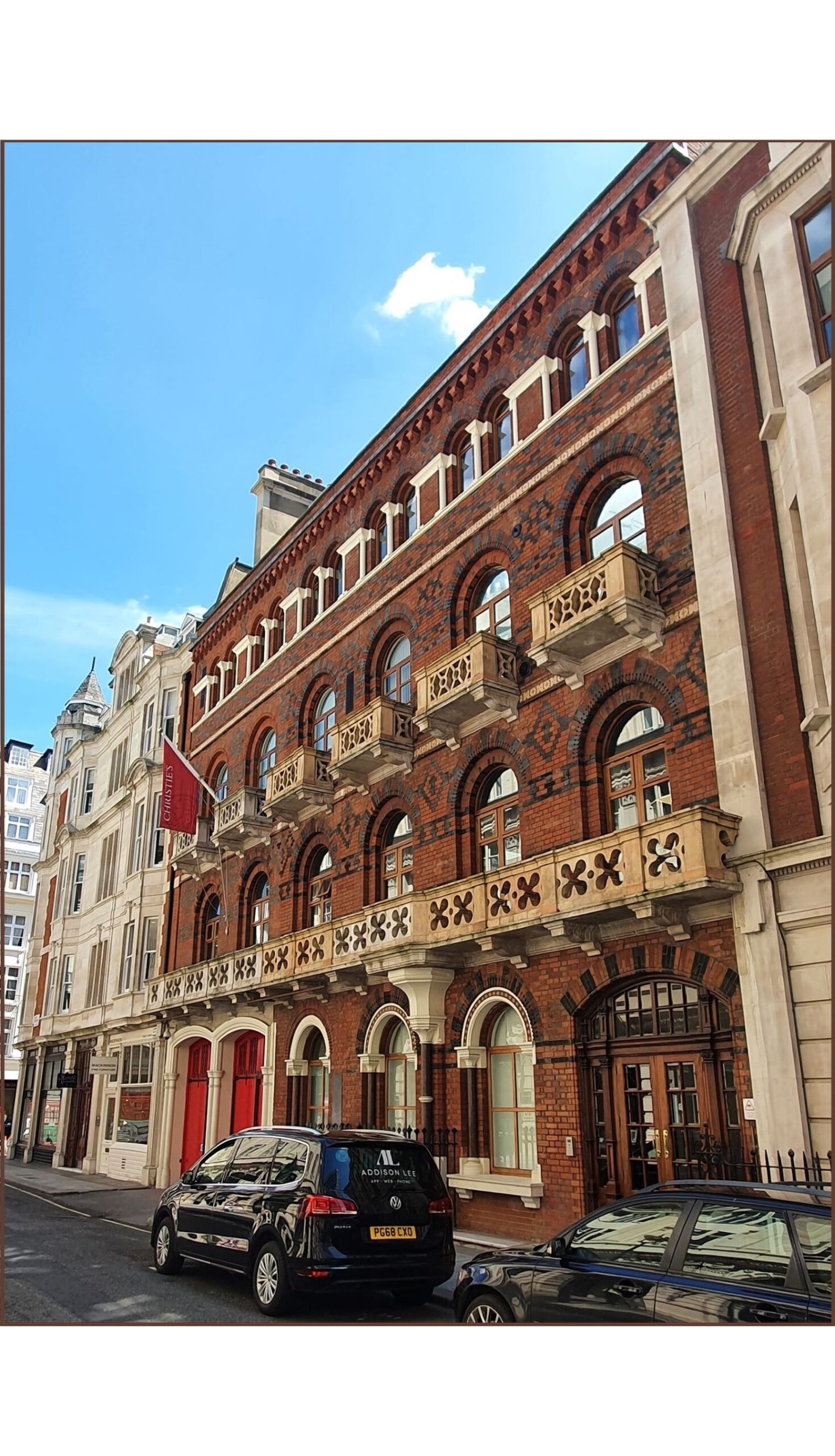
← The only one of my selection still standing, this is the former Dieudonné’s Hotel today. The Eccentric Club occupied No.11, closest to the camera, until its own demise in 1986. The building was internally reconstructed after war damage and is now part of Christie’s auction house.
Notre suggestion du jour: Dining opportunities at the smaller high-end hotels such as Claridge’s or Brown’s may hint at the style of Dieudonne’s, and for added realism will include your own bankruptcy if you take a wrong turn on the wine list.
Pagini’s (1871 – 1941)
Pagini’s, founded by two Italian brothers of that name, was in Great Portland Street, close to the Queen’s Hall. This made it popular with musicians and other entertainers; the more famous patrons – such as James Whistler, Nellie Melba, Sara Bernhardt, Giacomo Puccini – were invited to sign a wall in a private ‘artists room’on the 2nd floor, now preserved in the Museum of London. Newnham-Davis describes a meal he had with a respectable but – reading between the lines – thrill-seeking friend, a Mrs. Tota. He noted that Bortsch was the customary Sunday soup at Pagani’s, and thought it excellent. The pair also peeked into the ground floor dining room, which was full of dining musicians, and were shown the signed artists’ wall.
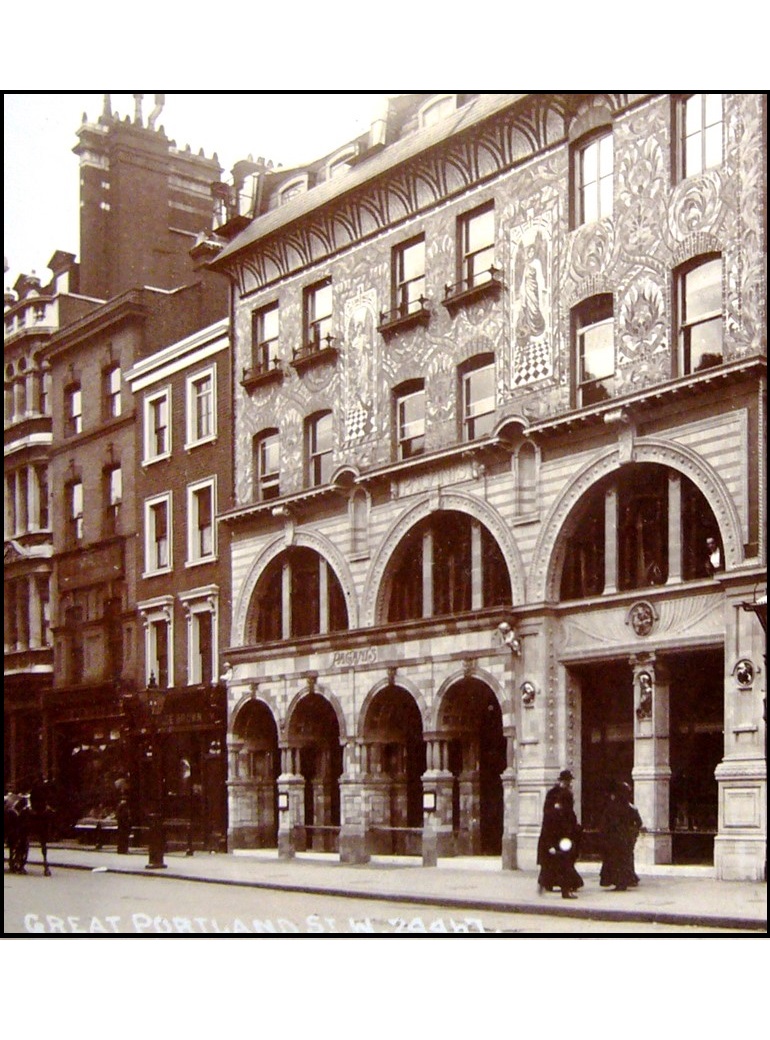
← The decorative terracotta and tile frontage: Newnham-Davis commented that ‘Glazed grey tiles front the whole of the ground floor … the deep entrance arches are supported by squat little blue pillars. The curve of the arches are set with rows of electric light, which give the … restaurant the appearance of having been illuminated for a fete every night.’
Pagini’s was reduced to a shell by bombs in 1941, never to reopen. It is remarkable the artists’ wall survived, and even more so that the cellar-full of wines did. They were ‘rescued’ by the proprietors of a nearby pub – perhaps the Mason’s Arms – who opened a small restaurant above the bar to make the most of this extraordinary coup.
If you want to capture the spirit of Pagini’s, Newnham-Davis helpfully provides the recipe for the filets de sole Pagini, so you can recreate one of the house specialties in your own home. My ‘serving suggestion’ would be to invite musicians and actors to dinner, and ask them to scrawl on your dining room wall.
“The sole is first of all filleted, and with the bones, some mussels, and a little white wine, a fumée de poisson is made in which the fillets of the sole are then cooked. The cook takes this cuisson, and by adding some well-chopped fresh mushrooms, makes with that what he calls a réduction; to this he adds some velouté, little cream, fresh butter, some lemon juice, pepper and salt, and cooks the whole together till well mixed, then passes it a l’étamine. With this the sauce is made. The cooked fillets of sole and 8 or 10 mussels are then placed ready on a silver dish, and the above made sauce poured over them. The top is well sprinkled with fresh Parmesan cheese, and after allowing them to gratiner for a minute or two, are ready to be put on the customer’s table.”
Notre suggestion du jour: The later Ivy in West Street might give a glimpse into the style of Pagini’s, although that has been more of an actors’ haunt. Kettner’s, a racy rival boasting a founder who was supposedly chef to Napoleon III and a cast of diners including, inevitably, Edward VII and Oscar Wilde, is now a hotel but still has a champagne bar and brasserie.
The Holborn Restaurant (1874 – 1955)
Probably the biggest of them all, this was a vast and more middle-class establishment on the corner of Holborn and Kingsway, opposite Holborn tube station.
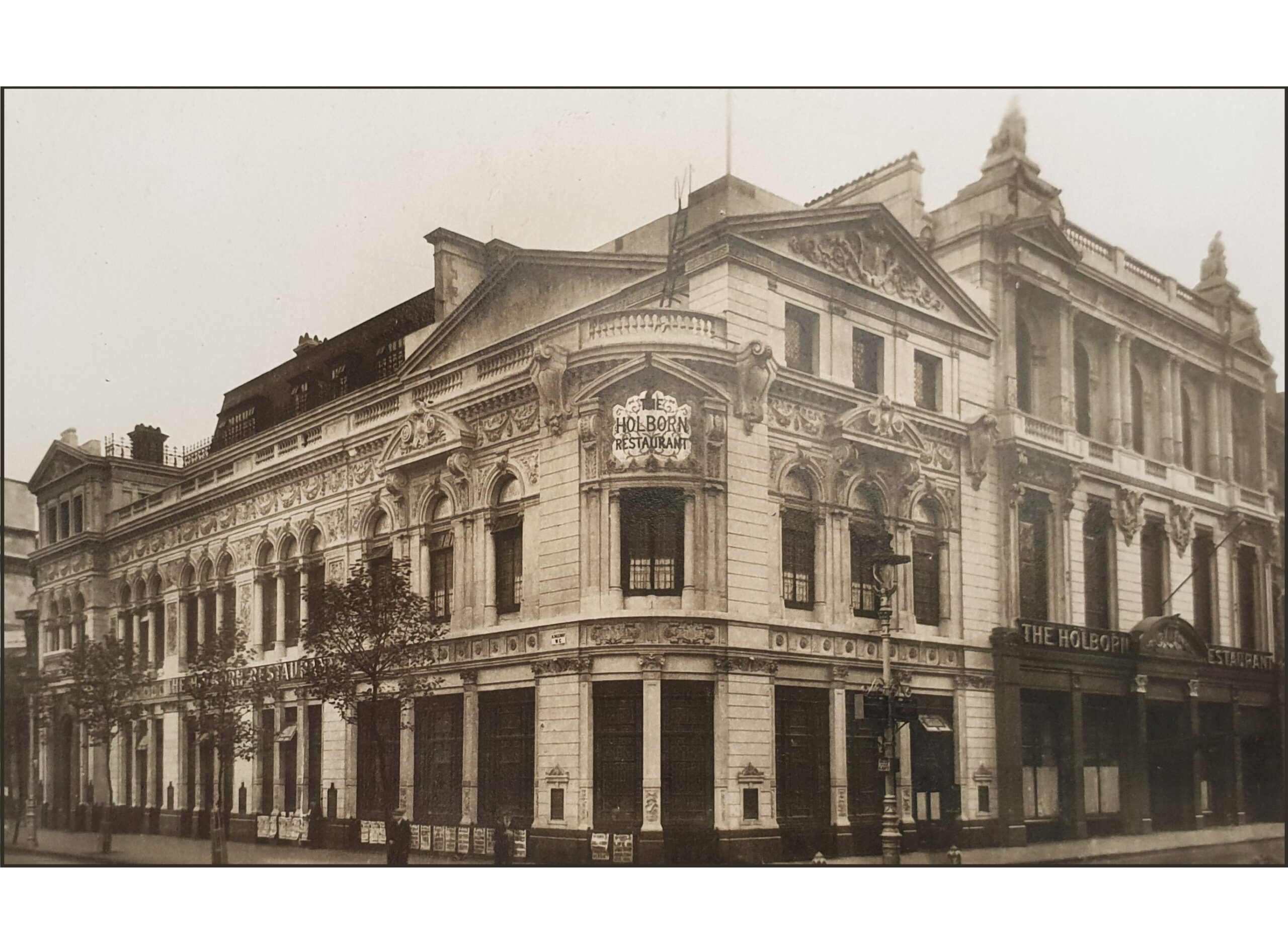
At its peak it boasted a grill room, grand restaurant with dancing and cabaret, private dining rooms and fourteen smaller restaurants. The proximity of entertainment offered by the Holborn Empire, Stoll Cinema and Kingsway Theatre, and shops such as Gamages meant a huge potential clientele.
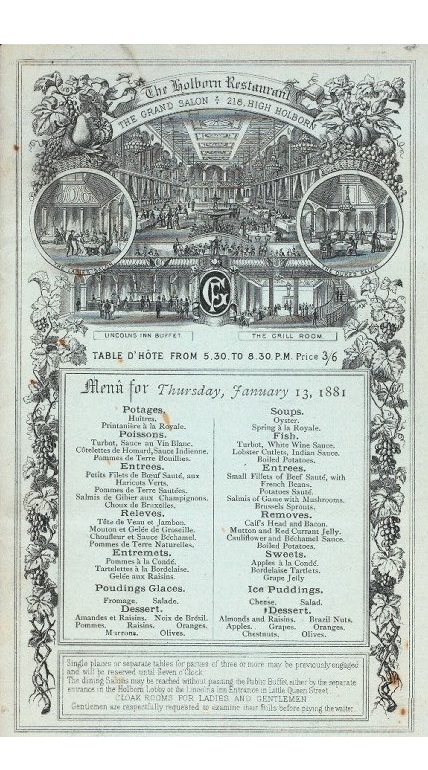
→ A menu for the Holborn Restaurant Grand Salon, January 1881. The extraordinary size of the establishment is revealed by the inclusion of illustrations of five separate restaurants, all in the same building. I like the exhortations to gentlemen to examine their bill before paying the waiter. Clearly, the possibility of a lady paying for a party, or even – heaven forbid – dining alone, had not entered the management’s heads.
When the Holborn area lost its nightlife after the Second World War, the restaurant became a white elephant and its closure inevitable. The subsequent sale of fixtures and fittings listed 960 chairs. The site is now occupied by a branch of Sainsbury’s.
Notre suggestion du jour: There is nothing comparable in modern London, although perhaps the more upmarket Ned, at 27 Poultry, with its 9 separate dining areas in the vast Edwin Lutyens-designed former banking hall, and further restaurants in the basement and on the roof terrace, at least gives the faintest whiff of the vastness of the Holborn Restaurant.
Romano’s (c.1881 – 1941)
Another Italian name now, with Romano’s on the Strand, the titular proprietor being known as ‘the Roman’. Above a small canopy, copper cupids danced. Within its rooms, a Byzantine style of decoration held sway (some sources call it ‘Moorish’). Ruling over it, Romano himself. Seated at the tables: actors and actresses, authors, lawyers, journalists, artists, city types and criminals, those of the turf. It was put on the map by a journalist on the Sporting Times (‘the pink ‘un’) writing about it, and a twin-sister music hall act singing about it. Edward VII dined there, as did the Gaiety Theatre chorus girls. At Romano’s, young men really did drink champagne from the shoes of the girls they adored.
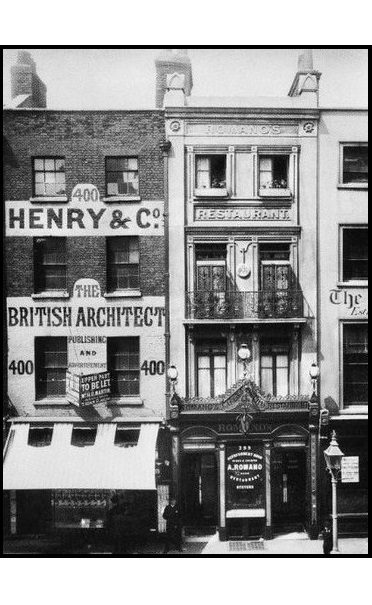
← An early picture of Romano’s, before it expanded into the former offices of Henry & Co. next door and acquired its fancy canopy.
A house specialty was soupe crème pink ‘un (a crayfish bisque, since you ask), to honour the newspaper that helped make the proprietor’s fortune. Our friend Newnham-Davis paid £2 4s (over £250 in 2020 money) for an á la carte dinner in 1899 with a neurotic, miniature dog-loving theatrical lady of a certain age, and secured the recipe for the soup:
“Put in a saucepan 2 ounces of butter and two teaspoonfuls of olive oil. Cut a carrot and an onion into small pieces, and let them cook gently for five minutes. Then take 24 live cray-fish, a pound of prawns, and 6 fresh tomatoes. Put these in altogether, and then add half a bottle of Chablis, and after having seasoned with salt and cayenne pepper, put the lid on the saucepan, and let it boil for 20 minutes. Have ready a pound of pearl barley which has been cooked for 3 hours, in ordinary stock. Pound in a mortar the cray-fish and prawns, with the barley, dilute with a pint and three-quarters of stock, and pass through a fine sieve. This done, put the soup back to warm again, without letting it boil. Add then a little cognac, in which you have steeped a bunch of thyme, two laurel leaves, and a little bunch of parsley, tarragon and chervil. Finish your soup by adding six ounces of fresh butter, and serve with sippets of fried bread.”
The introduction of a band and dancing after the First World War showed how things had changed. In the 1930s Romano’s made the radical decision to employ a coffee chef, Sulamon Kathwaroon. He offered thirty different flavours of Turkish, Arab or filter coffee by night while promoting Indian independence at Speakers Corner by day.
Romano’s was another victim of the Blitz. Badly damaged in 1941, an ‘American Bar’ remained open in the basement until demolition in 1948. Perhaps the ghosts of Romano and Kathwaroon can be glimpsed looking at the philatelic displays of Stanley Gibbons, which now occupies the site.
Notre suggestion du jour: The smaller Romano’s – it was never a grand café – brings to mind once again the Ivy; also Rule’s in Maiden Lane and Wilton’s in Jermyn Street, although both are older establishments and don’t have the bohemian reputation key to Romano’s legendary status. Sarastro’s in Drury Lane is (rather self-consciously) eccentric in both decor and behaviour, making it more of a tourist destination.
The Carlton Hotel (1899 – c.1949)
The Carlton was built in a single block with Her Majesty’s Theatre in the Haymarket. Both were designed by eminent theatre architect C.J. Phipps.
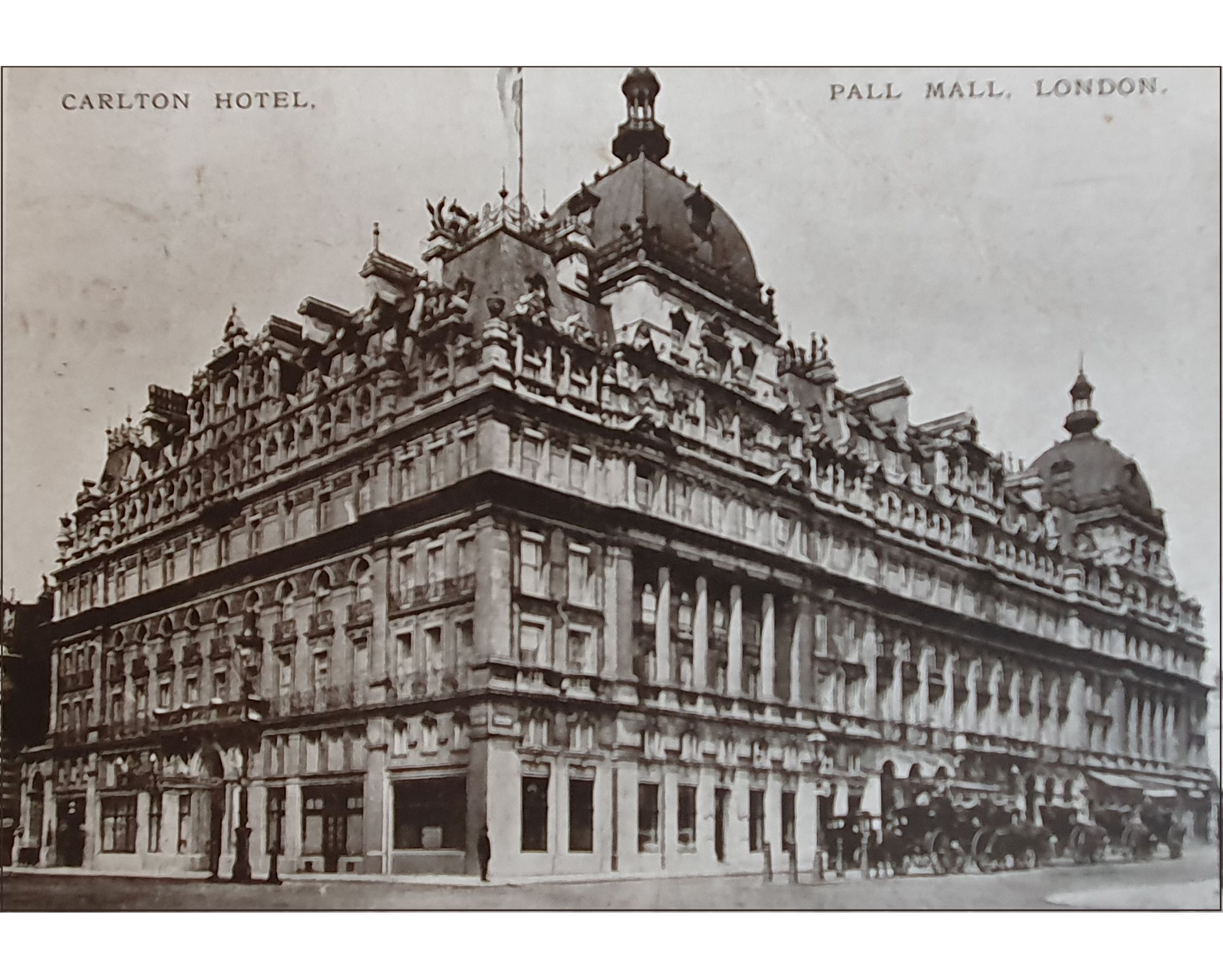
← The Carlton Hotel in its Edwardian heyday, with horse-drawn hackney carriages awaiting clients outside. The hotel occupied the left and centre blocks; the block to the right is the theatre.
The Carlton was resolutely upper-class. Escoffier was chef, and César Ritz manager until the postponement of the coronation of Edward VII triggered a mental breakdown.
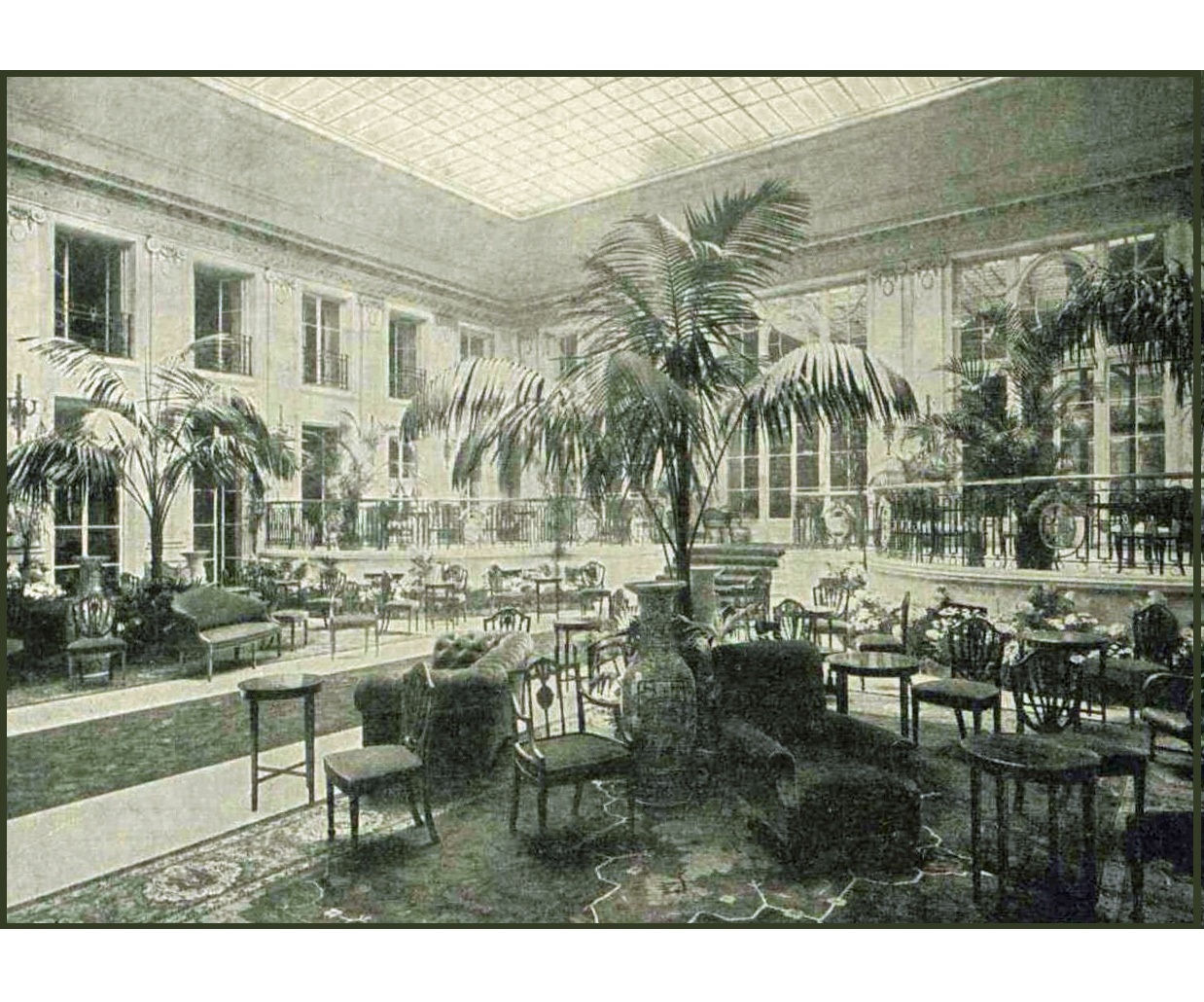
→The Palm Court was a home-from-home for Edwardian nobility; both Saki and Agatha Christie based short stories around encounters at the Carlton.
It was one of Edward VII’s favourite restaurants; in stark contrast, the future revolutionary Ho Chi Minh laboured in the kitchens for a time just before the First World War, and got understandably upset at so much food going to waste. Frenchman Escoffier moved him from dish-washing to cake-making rather than adopting the modern Pret a Manger food-donation approach; perhaps this was a small step on the path to the wars of independence in French Indo-China.
Bomb damage in 1940 put an end to the hotel, and although the grill room and American Bar plodded on – surrounded by civil servants after the Government requisitioned parts of the building – such an arrangement was not viable in the long term. The Carlton directors sold up (the company also owned the London Ritz, and concentrated on that), the grill room closed and the site was redeveloped.
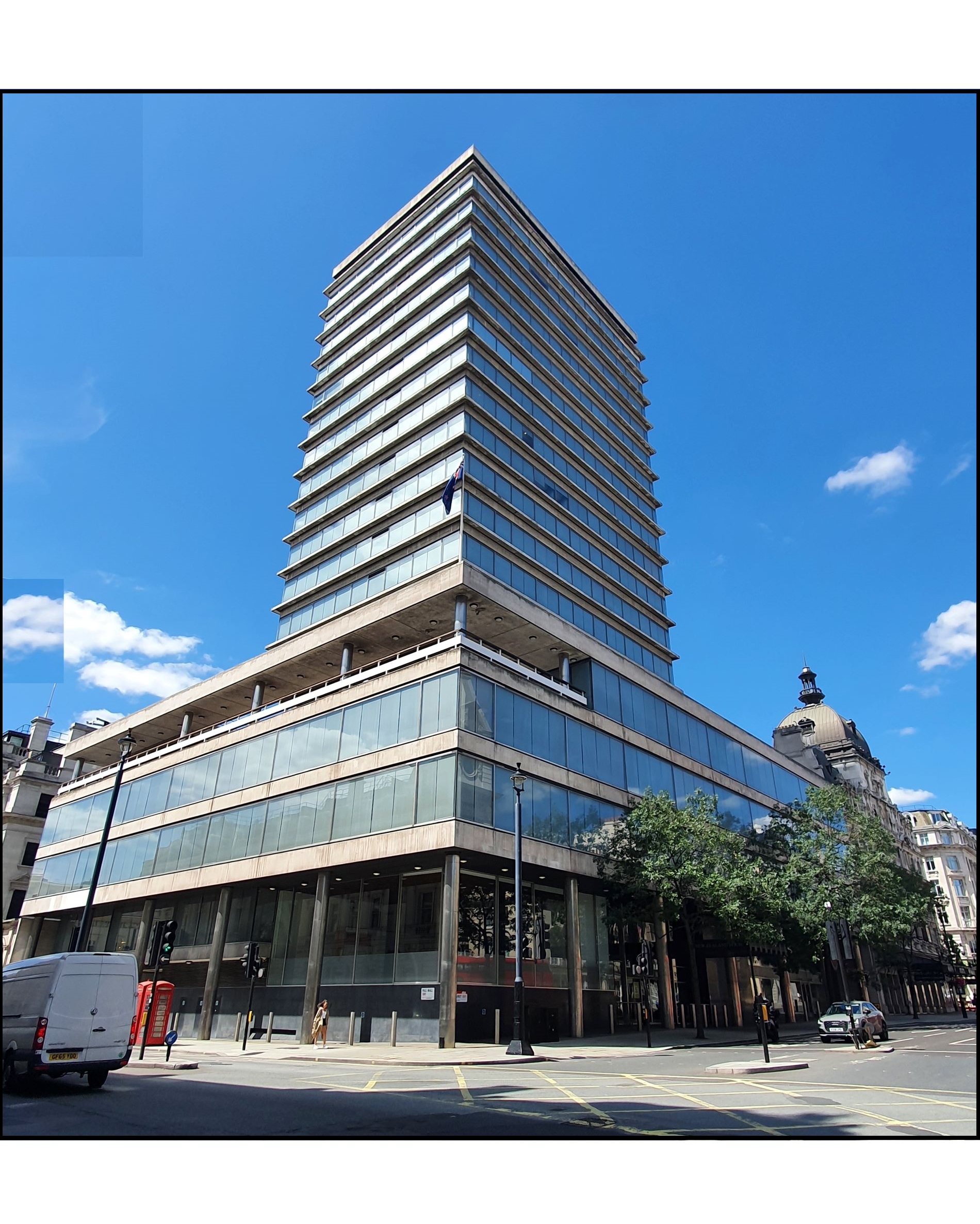
← Almost the same angle, 2020. The dreary 1960s bulk of New Zealand House dominates, bearing a blue plaque commemorating Ho Chi Minh rather than Edward VII. Her Majesty’s Theatre looks ill at ease with its modern neighbour, but we should be grateful it survived at all, given it was initially slated for demolition along with the hotel.
Notre suggestion du jour: To evoke the same sense of style, visit the Carlton’s erstwhile stablemate the Ritz, which has its own palm court.
Bon appetit!
Nearest Stations:
Selected Bibliography:
Credits:
Comments are closed.
Note that as a late bonus, I’ve updated this post to include the Edwardian photograph of Oxford Street which shows Frascati’s restaurant, 1st Sept 2020.